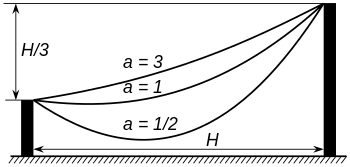Catenary
A catenary is an ideal curve that physically represents the curve generated by a chain, rope or cable without flexural rigidity, suspended from both ends and subjected to a uniform gravitational field. This word comes from the Latin catēnarĭus ('own of the chain'). The involute of a tractrix is a catenary.
History
The problem of the catenary, posed during the 17th century, consisted of determining the shape that a chain or rope adopted (without flexural rigidity) within a uniform gravitational field. That is, when the rope's own weight acted vertically on a rope segment and was supported simultaneously by the tensions at its ends, in directions tangential to a curve segment at its ends. The early physicists and mathematicians who tackled the problem assumed that the curve was a parabola, because empirically the shape of the string looks very much like a parabola, especially when small lengths of string are considered. But it was Christiaan Huygens, at the age of 17, who showed that the curve was not really a parabola, but only a similar curve, although he did not find the equation of the catenary.
The equation was derived by Gottfried Leibniz, Christiaan Huygens, and Johann Bernoulli in 1691, in response to a challenge posed by Jakob Bernoulli. Huygens was the first to use the term catenary in a letter to Leibniz in 1690, and David Gregory wrote a treatise on the curve that same year.
Mathematical approach
The equilibrium condition of a cable subjected to its own vertical weight leads to an in-plane equilibrium problem (the catenary is always a plane curve if the flexural stiffness of the cable can be neglected). From the local equilibrium condition of each point, the following differential equation for the slope of the catenary is derived, which relates the tensions at the ends of a section and its weight (see deduction of the catenary):
(1)
Where:
- is the weight per unit length, which is supposed to be constant.
- the horizontal tension that will appear on the ends of the cable.
The general solution is given by:
(2)
The solution of the previous equation for a cable suspended from two points at the same height and whose minimum point is the point (0,a) turns out to be:
is the horizontal component of the tension, which is constant, is the mass per unit of thread length and is the hyperbolic cosine function. If the catenary equation is developed in Taylor series () you get a curve close to a parable:
This corresponds to the equation of a parabola plus a fourth-order term. For this reason both graphs are so similar in the neighborhood of zero.
Important Relationships
In the case of a cable suspended from two points at the same height, the length of the arc, with the arc origin at the minimum is:
The inclination (that is, the tangent of said inclination) is:
Therefore, the vertical tension is:
The total tension of the thread is
with what to replace You got it.
Deduction of the catenary equation
The differential equation () can be derived by applying the balance of forces to an infinitesimal portion of catenary. Applying the balance of forces to the horizontal and vertical forces, we have:
Where:
- is the angle formed by the catenary and the horizontal.
- is the total voltage of the cable for each point.
- is the mass per unit of length.
The first of the equations implies that while the second of them can be properly written by choosing the origin of the arch length as:
Introducing the relationship between the tangent of the slope angle and the arc length:
Deriving the last relation yields precisely ().
In summary
A heavy, flexible, inextensible rope suspended from two points takes the shape of a catenary. This catenary is a flat curve whose equation using Cartesian coordinates (contained in the plane of the curve) and chosen so that the Y axis coincides with the minimum of the curve, turns out to be:
The curve is symmetrical with respect to the axis and, and near the lower point is much like the parable . This parable passes at all points below the catenary. This curve has the following properties:
- The vertex or minimum of the curve is given by .
- The length of the arc is
- The OAMP area is .
- The curvature radius is .
Generalizations
In general, the catenary equation refers to infinitely flexible and inextensible chains or ropes. The infinite flexibility requirement refers to the fact that the flexural rigidity is null and the inextensibility requirement refers to the fact that the length of each section of the same does not vary despite being subjected to forces. Obviously in real strings these requirements are met only approximately. For very long strings, the elasticity of the string takes it away from perfectly inextensible behavior. Although the catenary of an inextensible rope is always a flat curve, for thick cables of short length the finite flexural rigidity means that its deformed shape is not necessarily contained in a plane.
Applications
Given a linear element subjected only to vertical loads, the catenary shape is precisely the shape of the barycentric axis that minimizes stresses. This property can be used for the design of arches. In this way, an arch in the form of an inverted catenary is precisely the way in which the appearance of stresses other than those of compression is avoided, such as shear stresses or bending.
For this reason, an inverted catenary curve is a useful layout for an arch in architecture, a form that was applied, among others and fundamentally, by Antoni Gaudí. He himself used models to study these structures, to later dump that information into the plans of his works.
Contenido relacionado
Alternating current
Injective function
Higgs mechanism












![y(x)approx aleft[left(1+{frac {C_{2}}{a}}right)+{frac {1}{2}}{frac {(x-C_{1})^{2}}{a^{2}}}right]+O(x^{4})](https://wikimedia.org/api/rest_v1/media/math/render/svg/a6d8113d31901182ed0af63e43f91c0dfb407450)























